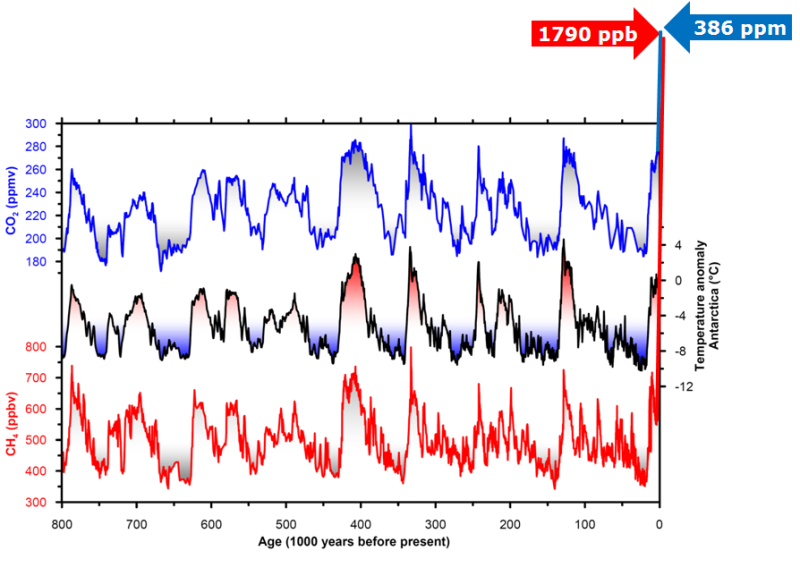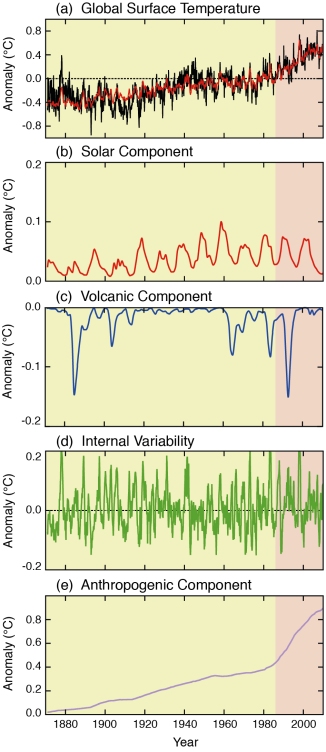In a few days, 2016 will officially shatter the record for the warmest year globally, the third year in a row that record will be broken. That’s a pretty serious trend, so I think it’s time to refresh ourselves on how to think about climate change, given the events that have happened this year. In a world where media dominates and tries to push ideas in one direction or another, it’ll benefit us all to sit back and look at unbiased facts. This way, we can hopefully make the topic of climate change less polarizing.
If we want to understand how Earth’s climate is changing today, we need know how it’s behaved in the past. After all, the argument “Well, the climate has always been changing” is brought up pretty frequently by skeptics and deniers. It turns out that the shape of Earth’s orbit around the Sun, the angle of Earth’s tilted axis, and the direction that Earth’s axis tilts play a huge role in determining global temperature over hundreds of thousands of years. These three factors are known as the Milankovitch Cycles, and you can read more about them here.
Take a look below at the history of Earth’s global temperature (black line). Yes, there have been lots of spikes and dips in the temperature record, some of them pretty sudden, but look at the time scale! These natural changes happened over thousands of years, compared to the sudden changes over the last 50 years or so. Look how closely the temperature line matches the carbon dioxide (blue) line and methane (red) line, both being greenhouse gases. It’s true that we need greenhouse gases just to survive, but having too much can heat things up really quickly.

The temperature graph you’ll see most often, whether it’s on TV or on social media, is the one from 1880 through today. Even in that short amount of time, just 136 years, the global temperature has risen 2ºF. Most of that increase has actually occurred within the last 50 years or so.
How do we know that human activity is to blame for a lot of that warming? The Intergovernmental Panel on Climate Change (IPCC) puts together an enormous report every few years to document aspects of climate change all around the world in great detail. In a section within the latest report looking at different causes for the sudden change in Earth’s temperature, it was determined that anthropogenic (human) changes were the main factor. Volcanic eruptions, influences from the Sun, and El Niño / La Niña had a smaller effect on the overall temperature rise.

Why would 2016, a single year in the long history of Earth’s temperature, be remembered as a year that sticks out when discussing climate change? Besides breaking last year’s temperature record by a huge margin, tropical systems from all around the globe showed some signals of influence by a warmer climate. Weather Underground documented 10 such events, many of which broke records for overall strength or rainfall produced.
To stay unbiased, there are also reasons that 2016 is “just another year” in climate history. In the tropics article above and with many of the extreme weather events that have happened this year, it’s important to stress that the events are only influenced by climate change, mostly to a very small extent.
Let’s take a closer look at a recent heat wave in the Arctic. For the second time in two months, temperatures in parts of the Arctic reached more than 30ºF above normal. In fact, there was a pretty big commotion when a station close to the North Pole hit 32ºF, warm enough to start melting ice. That’s very rare for late December, so it was worth getting attention, but it appeared that nearly all of the attention was focused on the Arctic and trying to make connections to climate change, instead of what was going on elsewhere.
While this heat wave was going on, Russia was under assault by an extraordinary cold snap. The temperature departures were so extreme, it would be the equivalent of New York City being stuck around -20ºF for a few days. Imagine the kind of media attention that would get!
https://twitter.com/RyanMaue/status/811797392685199360
From a science perspective, the phenomenon is referred to as “Warm Arctic, Cold Continents“. It’s a great refresher that the atmosphere and ocean are really connected as one complete system. Unfortunately, most people don’t look at things from a science perspective, and see this event one of two ways: “The Arctic is so hot…climate change must be happening now” or “Russia is seriously cold…I thought this thing was called global warming?”.
Another way of looking at it is to view the Arctic temperatures over the course of 2016, seen below. The obvious thing that stands out are all of the spikes in temperature (red line) compared to average (green line) during the cold months, but what’s interesting to me is that during the summer, temperatures stayed right around normal. The same can be said for past summers, too. Just pointing out that while the Earth is certainly warming, the warming is more noticeable during some seasons and in some places than others. I don’t want people to think that climate change means “all warming, all over the place, all the time”.

Where do we go from here? If we’re talking about next year, the answer is cooler. The strong El Niño event that lasted into the beginning of 2016 has faded away, so there won’t be as much heat released into our atmosphere from the oceans. In fact, the UK Met Office has released their global temperature forecast for 2017, noting that it should be cooler than both 2016 and 2015.
The long-term problem is that it appears that we have hit a new “baseline” when talking about global average temperature. After a strong El Niño event, global temperatures typically stay warmer than the previous 10-15 years. That’s why after the 1998 strong El Niño, temperatures weren’t really increasing much until about 2014. After 2016, I highly doubt global temperatures would be cooler than that 1998-2013 period. The fact that 2017 is predicted to be the 3rd warmest year on record, but would otherwise be referred to as a “normal” year when looking at El Niño / La Niña, really hits home.
No, it’s not the end of the world, like some media outlets want you to believe. There are some pretty big changes going on in our atmosphere, but we must be careful not to overreact to every big-time weather event we see. If we stop trying to divide ourselves on the issue and instead work together, then it’s something we can fix in the long run.

